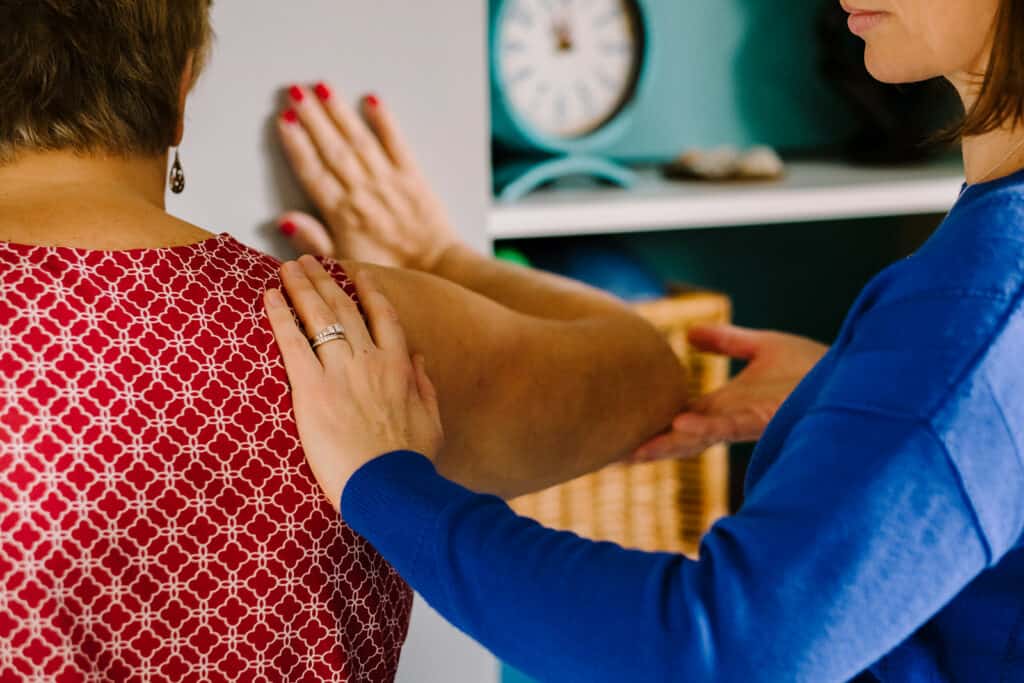Cancer-Related Lymphedema
Reducing the side effects of cancer and cancer treatment by integrating movement, education, and hands-on techniques with the science of the body-mind connection.
CDT TRAINED 13 years


Primary & Secondary Lymphedema
The lymphatic system is made up of organs, vessels, and nodes that work together to produce and transport lymphatic fluid from your tissues to your bloodstream, block and filter toxins, and generally defend your body from disease and infection. When this system is compromised, due to damaged or missing lymphatic nodes or vessels, lymphedema can occur.
There are two types:
Primary Lymphedema is caused by a developmental abnormality to the lymphatic system; symptoms may present immediately at birth or later in life (most commonly around puberty).
Secondary Lymphedema is the result of physical trauma to the lymphatic system after birth. The most common causes are surgery (e.g. lymph node biopsies or dissections), radiation therapy, cancer itself (if directly blocking the lymphatics), and infection.
Most often, it occurs in the arms and legs but it can also occur in other areas of the body such as the chest, neck, head, and pelvic region. It is very dependent on where in the body the lymphatic system has been damaged.
Common signs and symptoms of lymphedema include:
- Feelings of heaviness, tightness, aching, or itching in the affected area
- Clothing fitting more tightly than usual
- Jewellery and rings not fitting
- Visible swelling
- Pitting edema (your fingerprint stays behind after pressing on the body part)
- Skin thickness or hardness (fibrosis)
Complete Decongestive Therapy
Complete Decongestive Therapy (CDT) is the gold standard for treatment. A Certified Lymphedema Therapist will use the 4 pillars of CDT to help their clients treat and manage their symptoms.
This includes:
- Compression therapy
- Manual lymph drainage
- Exercise
- Skin care
In addition, education about self-care and lifestyle modifications (if required) are also part of an ongoing plan to manage symptoms. With treatment and the support of an informed healthcare team, excellent quality of life can be maintained and more serious health concerns can be avoided. Lymphedema can be treated at any stage, but the sooner it is identified, the easier it is to treat.
Cancer-Related Lymphedema Pathways
Comprehensive In-Person & Online Options
Lymphedema Smart
Learn everything you need to know about cancer-related lymphedema: what it is, how to reduce your risk, how to monitor & detect it early, and where to access skilled treatment if you think you’re developing lymphedema.
Breast Cancer Recovery Program
This comprehensive movement & education program will move you out of survival mode & into recovery mode. Learn what’s going on in your body, what to expect and targeted exercises to help you recover & feel better.
Virtual One-on-One Physiotherapy
Your virtual video appointments will be booked specifically with me. Treatments are personalized to your specific needs to improve your well-being and quality of life. (Available to residents of Ontario, Canada only)
In-Person One-on-One Physiotherapy
Your in-person appointments will be booked specifically with me. Treatments are personalized to your specific needs to improve your wellbeing and quality of life.
The Cancer Rehab Physio Experience
What people are saying
"Your online program and exercises were a game changer for my recovery; the overall content of the [Breast Cancer Recovery Program] is amazing. I wish I had had it when I was first diagnosed. It would have alleviated a lot of anxiety and questions."
Kelly
Diagnosed with Breast Cancer
“Thank you for being such a wonderful healer in my life in my darkest days. Not only are you tremendously skilled but you are a gem of a human being whose presence soothed and encouraged me each and every time I saw you. I feel so fortunate to have had you walk with me through the muck...”
Kim
Diagnosed with Breast Cancer
“I was thinking about [Beth] and the work [she does] and [has] done for me. I was hiking in the Gatineau and enjoying the moment. Body in motion, mind somewhat still. Thank you for your expert advice and positive attitude. You were teaching me how to give myself a bit more grace. Your videos of me doing the exercises and your excitement when I made progress helped so much! I am grateful.”
Christina
Diagnosed with Melanoma
"Beth has provided suggestions and treatment that have increased the range of movement of both arms, but even more significantly, made them feel like arms again so that I can participate in normal activities (eg. dragon boating) and be pain free. In the spirit of the body being "connected", Beth's intelligent approach results in improvements in whole body wellness, which she teaches the patient to maintain."
Ann
Diagnosed with Breast Cancer

